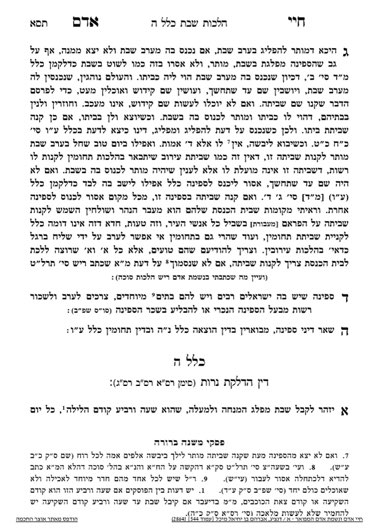We are beginning siman 4, where the Chayei Adam will discuss carrying on a boat. He writes that there are three points one must have in mind in order to carry on the boat; today we will discuss the first two.
The first point is that one can only carry in an enclosed area. The boat is considered an enclosed area due to the sides of the boat. The water surrounding it is considered a karmelis, and one (generally) cannot carry into the water or vice versa.
The second point is that when it comes to land, if there are multiple people dwelling within one courtyard, on a Torah level it is muttar to carry there (provided it is enclosed). However, Chazal instituted the need for an eruv chatzeiros. We need to explain the purpose of an eruv chatzeiros on land in order to understand the potential issue when it comes to a boat.
On a Torah level, there are three domains on Shabbos. The first is a reshus hayachid, which is defined by the fact that it is enclosed and made for human living. The second is a reshus harabbim, which is used by the public for gathering or traveling and is not enclosed. The third is a makom petur, which is any area which is not a reshus harabbim or reshus hayachid. On a Torah level, one can carry from a reshus hayachid or reshus harabbim into a makom petur, and vice versa. For example, a public park is not a reshus harabbim, since it is not made for the purpose of gathering, but is not a reshus hayachid either, as it is not enclosed. On a Torah level, it would be considered a makom petur.
Chazal enacted that areas which appear similar to a reshus harabbim are assur to carry in as well. They applied this issur to open areas available to the public even if not heavily used by the public. Chazal were concerned that once people were able to carry between a reshus hayachid or reshus harabbim and such an area, they would come to carry directly between a reshus hayachid and reshus harabbim, which is assur deoraysa. These areas are known as karmelis.
Within the enclosed area of a courtyard, one can get confused as well. On the one hand, it is an enclosed area, but on the other hand, the fact that it is used by multiple families may make it seem akin to a reshus harabbim. The usage of the words private domain and public domain in English help us understand the confusion. This area is not a private domain, because it is being used by multiple people. By mistakenly equating the word yachid and private, one can come the conclusion that if one can carry in a chatzer, one can carry in a public domain, i.e., a reshus harabbim. On a Torah level, the definition of yachid and rabbim is not the amount of people who use it, but whether it is enclosed or open. Nevertheless, Chazal understood that a courtyard can still be confusing in people’s minds, and that they may mistakenly think that if they can carry within a courtyard, they could carry within a reshus harabbim as well. Therefore, Chazal instituted the creation of an eruv chatzeiros, which serves to demonstrate that everyone within the courtyard functions as a single unit, as opposed to a reshus harabbim where everyone functions independently. Chazal instituted that we should use food to create an eruv chatzeiros, because by eating together we demonstrate that we function as one unit.
Any time a city eruv is made, an eruv chatzeiros is made as well, in order to combine all of the dwellings of the city.
Applying this concept to the boat, if there is a communal kitchen and dining hall for eating, it is equivalent to an eruv chatzeiros. Chazal understood that the primary area of a home is where a person eats, so if the members of the boat eat together, they are demonstrating that they are one unit and have fulfilled an eruv chatzeiros.
We will discuss the Chayei Adam’s next points in the upcoming shiurim, be’ezras Hashem.
Summary
The Chayei Adam will discuss conditions required to carry on a boat.
The first is that the boat has sides which can be considered an enclosure. This is assumed to be true for most boats automatically.
The second is the need for an eruv chatzeiros. On a boat, this second condition can be fulfilled if there is a central kitchen and dining hall for all members of the boat.



